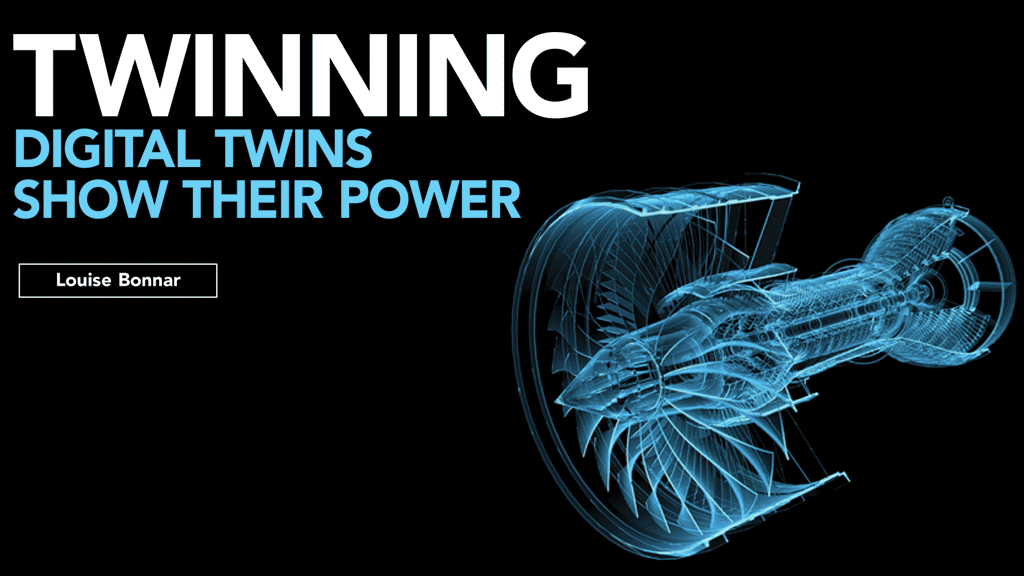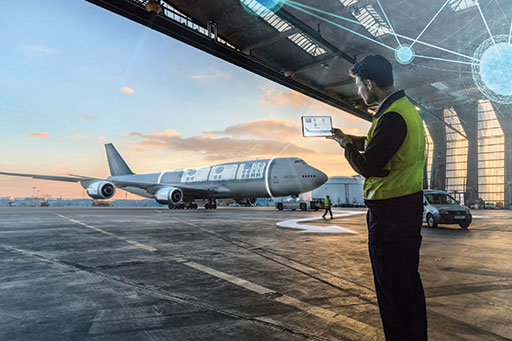
The potential of digital twins for aerospace is coming to light.
Digital twins, virtual simulations of physical assets, are finding their way into aerospace. Original equipment manufacturers (OEMs) can design new engines, airframes or complex components or test how assets will mature throughout lifecycles. These virtual models allow OEMs to refine maintenance contracts and aftercare processes; it can make the twin undergo stress tests that may not be logistically possible inside a laboratory; or it can test out new designs or re-designs to establish whether to begin manufacture for physical tests. Today, entire, complex digital twins of engines are in use by OEMs.
How far can this technology extend into the industry and is there a use case for non-OEMs to use them as well? “OEMs are leading the innovation, in particular engine manufacturers,” advises Nadine Etong, director, MRO Product Line at the Aerospace and Defense Business Unit, IFS. For instance, an OEM can use a virtual copy of an in-service engine to model operational scenarios that improve future designs. “Digital Twins can help us build up knowledge on how parts behave in service, which can then be used to help us be more intuitive when we design new parts,” adds Dr. Chris Heason, engineering specialist – Civil Aerospace at Rolls-Royce.
Rolls-Royce has pioneered the implementation of digital “twinning” within certain stages of manufacture and maintenance, with a designated Intelligent Engine program underway that designs, tests and manages its family of large aero engines digitally. By adding real operational data to a simulation, supplied by customers worldwide via the physical engines, Rolls-Royce can build a picture of the long-term life of its assets. This enhances maintenance programs and enables predictive and preventative maintenance to prolong time on wing. The aftermarket potential is significant. “Digital twins help us plan aftermarket to maximize fleet availability, minimize disruption, and optimize MRO capacity and throughput,” says Heason.
General Electric (GE) is using digital twins in its manufacturing process. “GE has already built digital twin components for its GE60 engine family and also helped develop the world’s first digital twin for an airplane’s landing gear,” says Etong. “Sensors placed on typical landing gear failure points, such as hydraulic pressure and brake temperature, provide real-time data to help predict early malfunctions or diagnose the remaining lifecycle of the landing gear.”
Etong adds that GE Aviation also creates digital replicas for its engines, giving the company an electronic trail for every single one. “This allows GE to monitor its performance, predict maintenance issues and, ultimately, reduce costs after the engine leaves the plant,” she says.
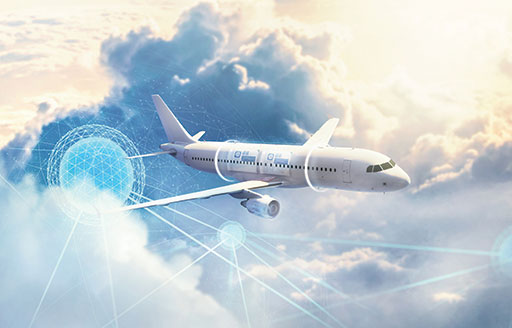
Maintenance Applications
Digital twins reap tangible benefits for OEMs. But can areas of the maintenance, repair and overhaul (MRO) industry can benefit from digital twins? “In MRO, we are right at the start of adoption,” explains Adrian Jennings, chief product advocate at Ubisense. “Digital twins of many kinds are becoming widely adopted in the manufacturing process, and that experience and technology is being fed into MRO.
“The initial focus within MRO tends to be on asset management, for instance tooling and ground support equipment,” continues Jennings. “Applications quickly grow into more process-oriented value than asset management. For example, intelligent pre-staging of tools and materials, automatic tool check in, check out, task error proofing, or automatic compliance monitoring.”
The current focus on digital twin technology lies in enabling preventative and predictive maintenance for airlines and MROs, which increases reliability and safety for the operator.
“The commercial aviation industry is going through major disruptions and companies, including MROs, are changing their business models to capitalize on new technologies,” says Etong. “Not just digital twins but also artificial intelligence (AI), the internet of things (IoT) and more. The initial focus is on engines, closely followed by components.”
MRO provider Lufthansa Technik (LHT) also designs and manufactures engine components in addition to developing repair processes. It therefore has the unique position of speaking from the viewpoint of operator, manufacturer and both airline and third-party MRO provider. “Digital twins are used very often to model design, certification, production and support of modifications, processes or even complete VIP Cabins,” adds Peter Isendahl, senior manager at LHT. “Sometimes even our advanced repair processes require a digital model of aircraft components to allow us to use it for automated MRO processes.”
AVIATAR
The first step into digital twins for LHT is AVIATAR, launched in 2017. A digital platform with numerous solutions focusing on condition monitoring, predictive maintenance and fault analytics, the overall goal for LHT is to create, for an airline, a complete replica of each aircraft in its fleet. For instance, engine health-related data (EHM) is fed through digital twins to help predict when a certain component will fail and will advise the user on AVIATAR.
“AVIATAR will allow airlines to benefit using digital solutions,” adds Isendahl. “Meanwhile, there are many other digital twin data models operational within the Lufthansa Group focusing on other areas of operation and hardware for aircraft, since Lufthansa Technik is also a production organisation.”
A digital twin requires data, however. Digital twins are currently developed by OEMs, and filtered down to operators or companies within the OEM network. To develop an accurate replica of a complex asset or component, the business building the CAD file will require access to intellectual property (IP), such as maintenance manuals and complex performance data parameters to reflect accurately. “There is a debate…about data ownership,” adds Etong. “OEMs need the data from many airlines. From an airline perspective, they are reluctant to be charged for additional services based on their own data even though they see the value they can get from a consolidated viewpoint. There must be an agreement between OEMs and their customers,” says Etong. Ultimately the IP belongs to the OEM.
“Digital Twins are taking off on the airline side, but it is slower with a focus on major sub-systems rather than the complete aircraft,” continues Etong. “MROs who have long-term agreements with VIP customers will collaborate with them as they do not have complete visibility on all aircraft operating condition data.”
Other Applications
Digital twins were originally introduced in production processes, to assist in developing, testing and monitoring new technologies. Currently, LHT is deploying digital twins in the design of aircraft cabins. “SkyRetreat” is a A220 VIP aircraft cabin concept developed by LHT, whereby digital designs were used in the initial design phase.
Digital twins are emerging in other areas, aside from engine OEMs and MROs. IFS and TEST-FUCHS have been working on a proof-of-concept together for the last year. Austrian-based manufacturing company TEST-FUCHS has implemented digital twins for the ground support assets and test equipment it manufactures. The project also addresses the potential for digital twins to be developed for pre “new-gen” components, which don’t always have sensors fitted.
An important conduit for the digital twin is sensor technology. Emerging assets all tend to have sensors, allowing for ease of data gathering. This is the channel providing most of the performance and health monitoring data to a CAD developed twin.
“We have found that it is possible to gather data on older assets, depending on the type of asset. IFS and TEST-FUCHS chose a hydraulic valve used on the Ariane 5 shuttle as part of its investigations into this area,” says IFS’s Etong. “The valve itself does not deliver data. However, the test equipment used to gather some measurements (such as resistance and impedance) delivers data about the valve. We were therefore able to gather the data we needed through the test equipment, but there are many different possible scenarios. Economically it is more viable if the company does not need to invest in additional tooling, material or software to upgrade existing equipment. Otherwise it is probably not viable, and a company should prioritize newer assets instead.”
The idea for TEST-FUCHS was to collect test results from some of their devices and test benches in the field. “These tests results are used for preventive maintenance but could be used as well for predictive maintenance,” continues Etong. “The digital twin of the component via IFS Applications can then be used for simulations, what-if scenarios and design improvements.”
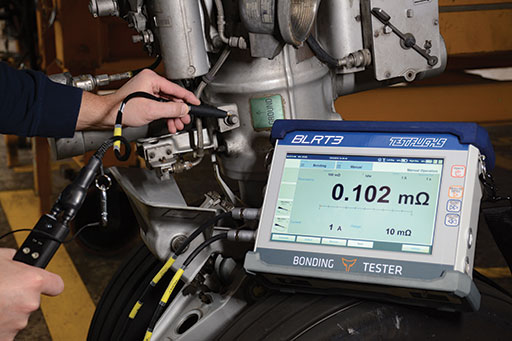
Engine and Airframe Aftermarket
The potential for digital twins to make an impact is in the engine and airframe aftermarket is big. IFS says that use cases are now out there. “Maintenance businesses are now using digital twin technology to focus on preventative maintenance,” says Etong. “There is now also a shift towards predictive maintenance. OEMs who are offering care programs, such as power-by-the-hour programs for engine MRO, need a lot of data, from various sources (airlines, MROs, lessors) to be able to generate trends. The intelligence behind this huge amount of data also helps inform the design of new assets, components and even whole engines.”
Digital twins are useful for a number of reasons in the aftermarket, elaborates Rolls-Royce’s Heason. “Within Rolls-Royce, our Services Digital Twins are virtual models of fleets of engines in in-service life. They combine utilisation, maintenance, route, environment, and performance data to understand future operational and maintenance demands. This helps Rolls-Royce to plan its aftermarket businesses which maximizes fleet availability, minimizes disruption, and optimizes MRO capacity.”
Digital twins also enable Rolls-Royce to carry out access simulations for new tools or repair processes that it wishes to implement. There are also less obvious benefits to the use. “Parts may move slightly in service and we may wish to see if our existing tools can still access the part,” explains Heason.
“In our blisk repair lab, we also deploy digital twin technology, as it enables us to drive automated repair processes by helping to create the necessary machine movement tool paths for material subtraction and addition,” says Heason. “As every part that needs repair is slightly different in geometry due to the operating regime the engine sees we need our repairs to adapt to these differences. As such creating a digital twin for each part we need to repair enables us to successfully implement this automated and adaptive repair.”
Heason explains that creating a digital twin also allows for better inspection of parts, enabling Rolls-Royce to assess changes to the part through its lifecycle and scheduled overhauls. They are actively deploying digital simulations to enhance repair techniques and processes. “For maintenance, there will be digital twins created for blisk repair for the Trent 1000, Trent 7000, and Trent XWB, ultimately the large aero engines,” explains Heason. “As engines start to employ more complex materials and components, more automated solutions are required and because of the adaptive requirement we have for these repairs, it is likely we will see greater uptake of this digital twin approach for future repairs.”
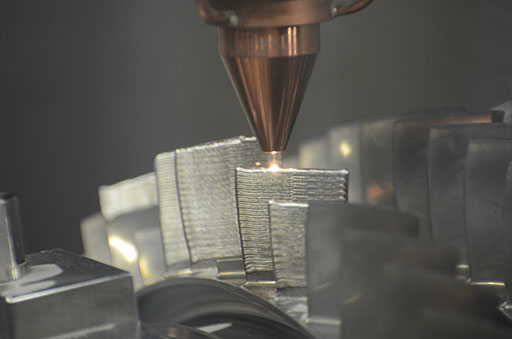
the OEM can adapt repairs to suit minute differences in geometry. Rolls-Royce image.
Considerations
Digital twin technology can extend the overall life of a new-gen aircraft, but can this be transferred to aging aircraft still in operation? MRO providers hope to leverage this technology without the association of a large airline motivating business processes.
“For any component or subsystem in an aircraft digital twins of physical shape could be developed using reverse engineering and processes could be re-modeled, but this can be a lengthy process which would require a solid business case,” says Isendahl. “If required and economically sensible, it is possible.”
This capability would not extend to all MRO providers, however. “Because independent MRO providers, outside of an OEM network neither own the asset or the configuration data, it is extremely difficult to gather the data required to run a digital twin,” highlights Etong. “An operator can provide the independent MRO access to their internet of things (IoT) solution if they have one. This will allow planners to have a better understanding of the aircraft condition…prior to aircraft arrival. The independent MRO can then feed such a solution with detailed information about the aircraft maintenance.”
The focus of the use of digital twins is on aircraft systems that benefit most from the concept. Complex components that cause the most disruption if faults are detected will be a priority for those leveraging the technology. “Airlines will typically focus on some key sub-systems such as engines, landing gear, hydraulic systems and avionics systems,” says Etong. For operators to use digital twins to progress preventative and predictive maintenance, the feeding of aircraft and engine health monitoring (AHM & EHM) into the twin is vital. “‘Day-to-day’ monitoring is done from day one and does not require historical data,” continues Etong. “AHM is one of the main sources of information. To plan for heavy maintenance however, such as a C-check, there is a need to collect months of historical data.”
Engine OEMs will utilize historical data in order to ensure the digital twin models developed in its testing facility are as representative of the physical twins as possible. “The amount required depends on the complexity of the system to be modelled and the accuracy required for the solution,” advises Heason. “As the quantity of data increases and the computing power to process becomes available, expectations of modeling accuracy also increase, and we will need to evolve the twins to suit.
“Within our blisk repair project we are creating a digital twin of a very complex component and only have conventional contact measurement data to compare back to the original manufactured part,” continues Heason. “Going forward, there will be a greater uptake of creating digital twins at manufacture, so we can access more data on how the part has dimensionally moved between initial build and overhauls.”

High-Tech Repair Processes
As the engines and components that power new-gen aircraft have grown in sophistication, so have the processes developed to repair and prolong the life of the asset. These so-called “hi-tech” repairs require significant knowledge of the asset’s design and development in addition to access to intellectual property (IP) and expensive tooling. A digital twin of the asset therefore assists repair shops and providers in developing and testing repair processes on the virtual asset before progressing into physical repair testing saving time and money.
“With data collected, data scientists and engineers can run simulations and determine corrective actions in advance of any defect or damage,” says Etong. “Note that there are already repair instructions provided by the aircraft manufacturer through SRM documents—however, an airline can push the envelope further and simulate more precise environments based on their operating conditions.
“Take the example of an airline which might be operating in a city where the fog level is higher than normal. Such an airline might want to gather some sub-system measurements under these weather conditions and overlay the data collected, with defects raised by technicians on the ground after the aircraft has landed and inspections have been performed.”
From the manufacturer’s perspective, Rolls-Royce’s Heason explains that a greater uptake of digital twin techniques through design, manufacture and service will enable OEMs to better predict what the input condition of the component will be when it reaches overhaul and aid the early phases of its repair development programmes. “Ultimately this will help us to develop and enhance techniques for hi-tech repair,” he adds.
Will there be a day when each engine and airframe within an airline has its own digital twin associated to it? “There is no reason why a nominal digital twin of an ‘ideal’ engine couldn’t be provided for each engine type given that CAD files exist for the parts, but for ‘real’ digital twin implementation is more challenging,” explains Heason. “The sheer number of individual components and the complexity of the technology required to create individual digital twins for every component mean that currently, it is sensible to identify key components for which having a digital twin is most useful.”
“In the next few years and decades all new-gen aircraft, engines and components will be available as digital twins,” adds Isendahl. “But more important are digital twins related to the aircraft operations. It is nice to know how an aircraft was delivered to an airline, but this is just a one-day snapshot. It’s the following 20 to 30 years when the operators have to maintain and modify the aircraft in order to comply with passenger and authority expectations.”
Digital Process Twins
The reliabilities generated by digital twins can extend to reliability across an entire business. “Increasingly, businesses are employing software systems to help plan and manage complex processes,” says Jennings of Ubisense. “Aircraft MRO is a series of complex processes. While planning systems have become more sophisticated, virtually replicating a shopfloor to forecast operations is the next step.”
LHT‘s Isendahl sees the potential of digital process twins – particularly within logistics. “It happens already in other industries and LHT is making strides into this area,” he says. LHT’s Digital Warehouse is an example. By digitising and automating many of the processes that occur within its warehouse, LHT is able to develop a digital image of the day-to-day movements and therefore a digital representation of the warehouse. Examples of automated processes include wearable scanners that read RFID tags. By adopting these processes within the physical warehouse, LHT is able to build a real-time virtual image of inventory movements that arrive/depart the building.
“MROs can leverage digital twin technology to streamline their supply chain network,” adds Etong. “Running a digital twin for an asset is only the first step, the aim is to extrapolate this to create a digital twin of a whole fleet of assets. Take this a step further and a digital twin of the fleet can become part of a digital twin of an entire business, with process flows visualized and bottlenecks flagged in real-time—much more valuable than one single model.”
Digital twins could enhance logistics and forecast potential incidents that will cause delays. “MRO operations are a mix of routine and non-routine tasks, where the total work is unknown before the process commences,” adds Jennings. “A plan will need to be updated the moment a non-routine issue surfaces for instance. Even without the non-routine tasks, routine inspections encounter delays.
“Software planning systems therefore need to understand what’s happening on the hangar floor: they need to be able to monitor what’s going on so they can answer not ‘what is the next step in the plan?’ but ‘what’s the next step that will allow us to remain on schedule even though we’ve veered off plan?’”
What the planning systems need is a view of exactly what has happened and is currently happening on the hangar floor. Jennings explains that it needs to know the real-time status and interactions of people, tools, materials and tasks so the MRO knows exactly where it is in the process and can define next steps. This is the Digital Process Twin. “With that visibility planning systems can constantly adjust and correct for issues as they arise, not blindly following the original plan but constantly updating it to maintain efficiency,” he says. This is where the true potential of digital twins come into play.
Extending the digital twin to an organization level is certainly possible, agrees Heason of Rolls-Royce. “Digital twin techniques are extremely adaptive. While for us the digital twin is part of a comprehensive suite of digital models, in addition to being designed, tested and maintained in the digital twin environment, our aero engines will become increasingly connected. This means the physical asset and services provided can become further aligned.”
Ubisense Smartspace
Much of the information already exists to simulate processes on an MRO’s shopfloor. “Tool databases already include information about maintenance and calibration state and plans already allocate tools to tasks,” says Jennings. “The additional questions to answer include: where exactly are those tools? Are they being used by a qualified technician? Are they being used in the right task? Is that task running late jeopardizing the next task that needs the tool? Can we expedite tool transfer from one task to the next, bypassing the tool store?
“So the additional information required is the physical location of all the relevant assets, and that comes from a variety of different RFID technologies ranging from passive RFID to Bluetooth low energy and ultra-wideband,” continues Jennings. “The overall goal is to add the context of location, flow and interaction to existing business data in order to stitch the whole hangar floor picture together into a digital twin.”
In terms of installation time, a single workstation could be up and running within a few weeks, and a large facility within a few months. According to Jennings, the biggest effort is the physical installation of sensors, which is done so as not to interfere with hangar operations. Once installed, sensors go through a one-time commissioning process and are then connected with the software platform operating the digital twin.
SmartSpace takes the raw data from sensors and synthesizes that with other existing data. Its engine models the expected process flow and alerts planning systems the moment an issue arises. The goal is always to detect and correct errors, and to minimize turnaround time by maintaining efficient, coordinated process flow across the entire hangar, says Ubisense.
For the physical twin, sensors are installed up high in the hangar infrastructure, normally looking downward and inward into the workstations. A network of sensors covers the entire hangar floor or areas of critical interest. “Once installed, sensors are unobtrusive and require little to no maintenance,” Jennings says.
Assets to be incorporated in the digital twin would then require an RFID tag to be fitted, which is typically a battery-operated active tag with a lifetime spanning several years.
Future of the Digital Twin
“AVIATAR has been live for over two years, but we were already using process modelling and 3-D design for many years before that date,” Isendahl says. “The advantages today are the new digital technologies, computing power and cloud-based solutions. This allows us to introduce more efficient digital solutions quicker, yet compared to aircraft life cycles of more than 30 years, these are the “early days” for digital twins and digital cooperation. “
“The global digital twin market size is expected to reach $26.07 billion by 2025—registering a strong CAGR of 38.2% over the forecast years,” says Etong, “and we are now starting to see the first successful use cases of digital twins in action in commercial aviation, but there is more to come.” As the potential for digital twins expands across the industry, non-OEMs can explore the benefits for their business and assets. By utilising platforms developed by software providers that can perform the data mining and simulation required to develop a twin, the concept will continue to flourish.
